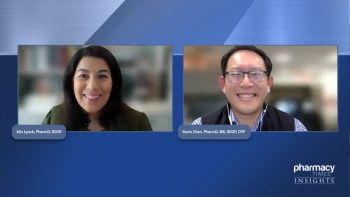
Overview of IKEMA and CANDOR Trial
Experts discuss the results of the IKEMA and CANDOR trials.
Episodes in this series

Ryan Haumschild, PharmD, MS, MBA: Over the last couple of years, a lot of new data have emerged. Dr Ali, I know you’re familiar with this, but specifically, from the CANDOR and the IKEMA trials, can you provide us insights into the efficacy and safety results of these studies? And if you would, discuss the implications of these trials on the treatment of relapsed/refractory multiple myeloma.
Amir Ali, PharmD, BCOP: That’s a fun question. We typically don’t like to compare trials head-to-head like this, so we’ll take everything I’m about to share with a grain of salt. But there are important distinctions that we can make when we look at these 2 similar trials and using similar products. One is the IKEMA study, which incorporates isatuximab, which is a CD38 agent in combination with carfilzomib and dexamethasone. The CANDOR study combines daratumumab with carfilzomib and dexamethasone.
The one nuance I will share just before we dive into the study is there are differences in the mechanisms of the CD38 products when you look at the two. When you compare daratumumab to isatuximab, isatuximab binds to a different epitope, and it causes the addition essentially of apoptosis, which is a unique mechanism for this CD38 product. Then you look at the baseline characteristics, the study design, and you look at the differences between the two, starting with the IKEMA trial, they included patients with asthma and COPD [chronic obstructive pulmonary disease], where you didn’t see that with the CANDOR trial. They also included patients with a lower GFR [glomerular filtration rate], so they had more robust renal data in that study. Then they stratified more of these high-risk cytogenetics in the IKEMA trial, so specifically looking at those gain 1q chromosome patients, which are now considered high-risk cytogenetics. Gain 1q is associated with higher disease burden, advanced disease for these patients. On the flip side, if you look at the CANDOR trial, they included patients with prior carfilzomib, which the IKEMA trial did not. Those are some basic differences when you look at that even before you look at the results.
But when you do look at the results, the initial readouts were fairly comparable, when you look at median progression-free survival [PFS], MRD [minimal residual disease] negativity rates. You also see isatuximab did well in those renal patients. In that study, the renal patients did better than the intent-to-treat arm, which was quite interesting. But then you look at the CANDOR study, and the overall response rates in that study were slightly better than in the IKEMA study. Safety profile, again, there was not much of a difference. I think if you look at raw numbers, the biggest thing when you compare the two are the infusion reactions that are happening for these patients. And CANDOR also used IV [intravenous] daratumumab. So, if you look at the raw numbers for the infusion reactions, it looks like for IV versions of both, you see fewer in the IKEMA trial. You also see cytopenias in both of these.
Now the last point, and Dr Hannah mentioned this, is the updated IKEMA results. Those came out recently in 2022, and that’s starting to distinguish the 2 studies. The main finding was the updated PFS, and they saw a 44-month PFS. That’s almost 4 years, and that’s been shown to be unprecedented in the relapsed/refractory setting for these CD38 regimens. So very impressive to see the updated data in that study.
Ryan Haumschild, PharmD, MS, MBA: That was a great overview, and you did a great job comparing the trials. I want to get everyone’s input on this. Dr Hossain, when you look at the data that we’ve heard about from Drs Hannah and Ali, how do you think the IKEMA trial compares to the CANDOR trial? Do you have any differences in opinions there? And what do you think are the long-term impacts of these follow-up data from the IKEMA and CANDOR trials?
Shahrier Hossain, PharmD, BCOP: I think we have to always keep in mind that we really shouldn’t compare trials like this head-to-head, but we’re going to do it anyway. What I always like to start off with is looking at the control arms, looking at the carfilzomib arms alone. I think in the IKEMA arm, it’s interesting that those patients are doing a bit better than in the CANDOR arm. So using that as a baseline reference comparing the rest of the data, I think the median follow-up was 44 months, as mentioned, in the IKEMA trial and about 28 months in the CANDOR trial. The response rates were pretty similar in the sense that it was 87% vs I think 85% or 84%. And in terms of complete responses, it showed that the IKEMA trial did better, but again, the carfilzomib arm also did better. So to me, it’s a bit of the same. These are just proving that anti-CD38 monoclonal antibodies are effective in this strategy. Just choosing between them may ultimately mean patient preference. Do you want to come in twice a month in the end, or do you want to come in once a month?
Ryan Haumschild, PharmD, MS, MBA: I like how you brought patient preference into the consideration. It’s always something we need to think about more that we might not always. Thank you for bringing that up.
Transcript edited for clarity.
Newsletter
Stay informed on drug updates, treatment guidelines, and pharmacy practice trends—subscribe to Pharmacy Times for weekly clinical insights.













































































































































































































